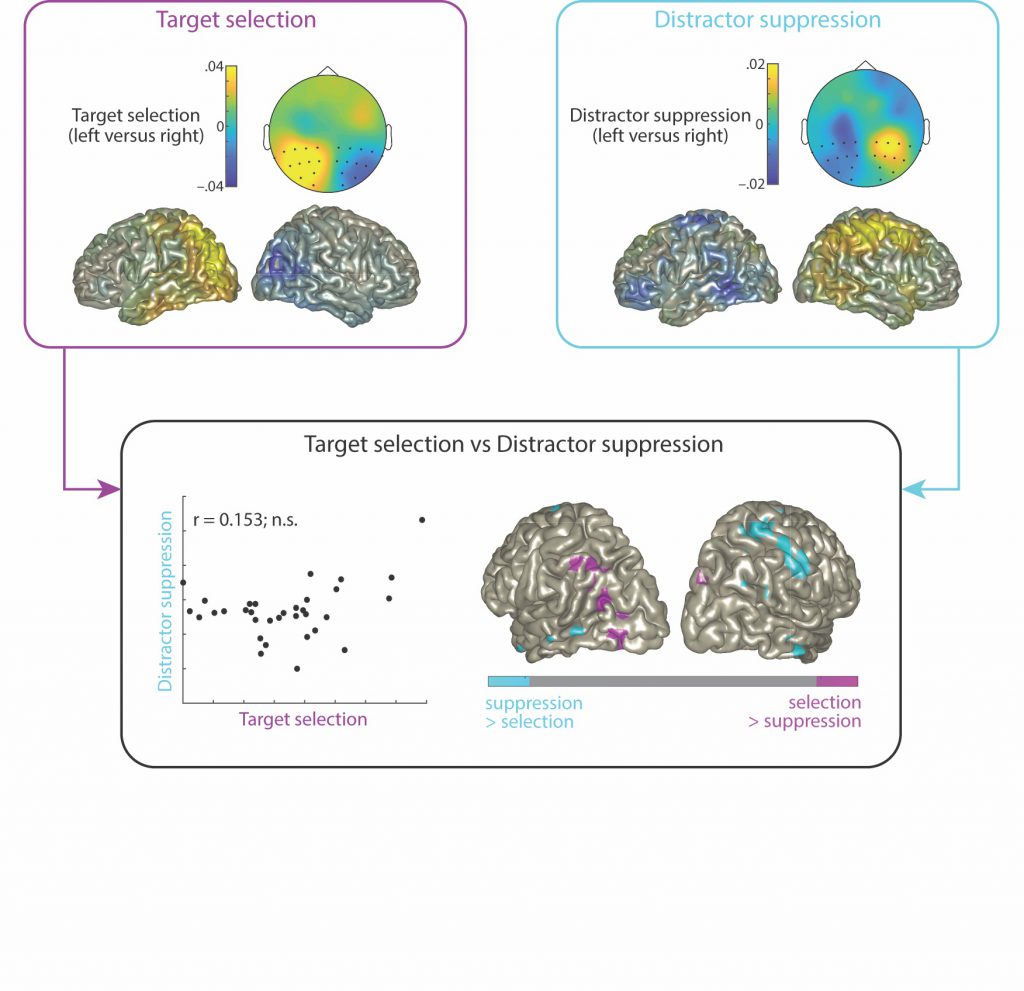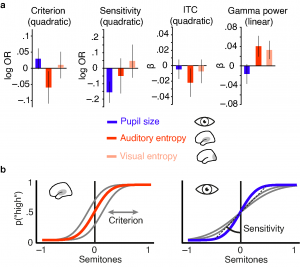Here’s a brand new PhD training opportunity, @dfg_public-funded, joint project of @ObleserLab at @UniLuebeck Germany, supervised by me, with star collaborator @GesaHartwigsen (@MPI_CBS) — starting next spring. Please be in touch. Please distribute widely. https://t.co/oTUEVVgQSG pic.twitter.com/L4DtFaqRJl
— Jonas Obleser (@jonasobleser) October 19, 2021
Category: Speech
Very excited to announce that former Obleser lab PhD student Lea-Maria Schmitt with her co-authors *) is now out in the Journal Science Advances with her new work, fusing artifical neural networks and functional MRI data, on timescales of prediction in natural language comprehension:
“Predicting speech from a cortical hierarchy of event-based time scales”
*) Lea-Maria Schmitt, Julia Erb, Sarah Tune, and Jonas Obleser from the Obleser lab / Lübeck side, and our collaborators Anna Rysop and Gesa Hartwigsen from Gesa’s Lise Meitner group at the Max Planck Institute in Leipzig. This research was made possible by the ERC and the DFG.

Frauke Kraus, Sarah Tune, Anna Ruhe, Jonas Obleser & Malte Wöstmann demonstrate that unilateral acoustic degradation delays attentional separation of competing speech.
Unilateral cochlear implant (CI) users have to integrate acoustically intact speech on one ear and acoustically degraded speech on the other ear. How interact unilateral acoustic degradation and spatial attention in a multitalker situation?
N = 22 participants took part in a competing listening experiment while listening to an intact audiobook under distraction of an acoustically degraded audiobook and vice versa. Speech tracking revealed not per se reduced attentional separation of acoustically degraded speech but instead a delay in time compared to intact speech. These findings might explain listening challenges experienced by unilateral CI users.
To learn more, the paper is available here.
We are very excited to share that Obleserlab postdoc Sarah Tune has a new paper in Nature Communications. „Neural attentional-filter mechanisms of listening success in middle-aged and older participants“ is our latest and to-date most extensive output of the longitudinal ERC Consolidator project on adaptive listening in ageing individual (AUDADAPT).
This co-production with current (Mohsen Alavash and Jonas Obleser) and former (Lorenz Fiedler) Obleserlab members, takes an in-depth and integrative look at how two of the most extensively studied neurobiological attentional-filter implementations, alpha power lateralization and selective neural speech tracking, relate to one another and to listening sucess.
Leveraging our large, representative sample of aging listeners (N=155, 39–80 years), we show that both neural filter implementatins are robustly modulated by attention but operate surprinsingly independent of one another.
In a series of sophisticated single-trial linear models that include variation in neural filter strength within and between individuals, we demonstrate how the preferential neural tracking of attended versus ignored speech but not alpha lateralization boosts listening success.
To learn more, the paper is available here.
Episode 4 of the Language Neuroscience Podcast. Ever wondered about the role of neural oscillations & neural entrainment in speech & language? Well I have… so I invited the great @jonasobleser to come talk about it. I really enjoyed this conversation! https://t.co/vflcfxbLS5 pic.twitter.com/BPkruYV26E
— Stephen Wilson (@smwilsonau) March 9, 2021
Thanks to colleague Stephen Wilson from Vanderbilt University for inviting me to this conversation!
The episode with Jonas is also available on Spotify.
— Ein deutsches automatisch erstelltes Transkript ist hier erhältlich (alle Übersetzungen ohne Gewähr).
Congratulations to Obleserlab postdoc Julia Erb for her new paper to appear in eLife, “Temporal selectivity declines in the aging human auditory cortex”.
It’s a trope that older listeners struggle more in comprehending speech (think of Professor Tournesol in the famous Tintin comics!). The neurobiology of why and how ageing and speech comprehension difficulties are linked at all has proven much more elusive, however.
Part of this lack of knowledge is directly rooted in our limited understanding of how the central parts of the hearing brain – auditory cortex, broadly speaking – are organized.
Does auditory cortex of older adults have different tuning properties? That is, do young and older adults differ in the way their auditory subfields represent certain features of sound?
A specific hypothesis following from this, derived from what is known about age-related change in neurobiological and psychological processes in general (the idea of so-called “dedifferentiation”), was that the tuning to certain features would “broaden” and thus lose selectivity in older compared to younger listeners.
More mechanistically, we aimed to not only observe so-called “cross-sectional” (i.e., age-group) differences, but to link a listener’s chronological age as closely as possible to changes in cortical tuning.
Amongst older listeners, we observe that temporal-rate selectivity declines with higher age. In line with senescent neural dedifferentiation more generally, our results highlight decreased selectivity to temporal information as a hallmark of the aging auditory cortex.
This research is generously supported by the ERC Consolidator project AUDADAPT, and data for this study were acquired at the CBBM at University of Lübeck.
Obleserlab senior PhD student Leo Waschke, alongside co-authors Sarah Tune and Jonas Obleser, has a new paper in eLife.
The processing of sensory information from our environment is not constant but rather varies with changes in ongoing brain activity, or brain states. Thus, also the acuity of perceptual decisions depends on the brain state during which sensory information is processed. Recent work in non-human animals suggests two key processes that shape brain states relevant for sensory processing and perceptual performance. On the one hand, the momentary level of neural desynchronization in sensory cortical areas has been shown to impact neural representations of sensory input and related performance. On the other hand, the current level of arousal and related noradrenergic activity has been linked to changes in sensory processing and perceptual acuity.
However, it is unclear at present, whether local neural desynchronization and arousal pose distinct brain states that entail varying consequences for sensory processing and behaviour or if they represent two interrelated manifestations of ongoing brain activity and jointly affect behaviour. Furthermore, the exact shape of the relationship between perceptual performance and each of both brain states markers (e.g. linear vs. quadratic) is unclear at present.
In order to transfer findings from animal physiology to human cognitive neuroscience and test the exact shape of unique as well as shared influences of local cortical desynchronization and global arousal on sensory processing and perceptual performance, we recorded electroencephalography and pupillometry in 25 human participants while they performed a challenging auditory discrimination task.
Importantly, auditory stimuli were selectively presented during periods of especially high or low auditory cortical desynchronization as approximated by an information theoretic measure of time-series complexity (weighted permutation entropy). By means of a closed-loop real time setup we were not only able to present stimuli during different desynchronization states but also made sure to sample the whole distribution of such states, a prerequisite for the accurate assessment of brain-behaviour relationships. The recorded pupillometry data additionally enabled us to draw inferences regarding the current level of arousal due to the established link between noradrenergic activity and pupil size.
Single trial analyses of EEG activity, pupillometry and behaviour revealed clearly dissociable influences of both brain state markers on ongoing brain activity, early sound-related activity and behaviour. High desynchronization states were characterized by a pronounced reduction in oscillatory power across a wide frequency range while high arousal states coincided with a decrease in oscillatory power that was limited to high frequencies. Similarly, early sound-evoked activity was differentially impacted by auditory cortical desynchronization and pupil-linked arousal. Phase-locked responses and evoked gamma power increased with local desynchronization with a tendency to saturate at intermediate levels. Post-stimulus low frequency power on the other hand, increased with pupil-linked arousal.
Most importantly, local desynchronization and pupil-linked arousal displayed different relationships with perceptual performance. While participants performed fastest and least biased following intermediate levels of auditory cortical desynchronization, intermediate levels of pupil-linked arousal were associated with highest sensitivity. Thus, although both processes pose behaviourally relevant brain states that affect perceptual performance following an inverted u, they impact distinct subdomains of behaviour. Taken together, our results speak to a model in which independent states of local desynchronization and global arousal jointly shape states for optimal sensory processing and perceptual performance. The published manuscript including all supplemental information can be found here.
Wöstmann, Alavash and Obleser demonstrate that alpha oscillations in the human brain implement distractor suppression independent of target selection.
In theory, the ability to selectively focus on relevant objects in our environment bases on selection of targets and suppression of distraction. As it is unclear whether target selection and distractor suppression are independent, we designed an Electroencephalography (EEG) study to directly contrast these two processes.
Participants performed a pitch discrimination task on a tone sequence presented at one loudspeaker location while a distracting tone sequence was presented at another location. When the distractor was fixed in the front, attention to upcoming targets on the left versus right side induced hemispheric lateralisation of alpha power with relatively higher power ipsi- versus contralateral to the side of attention.
Critically, when the target was fixed in front, suppression of upcoming distractors reversed the pattern of alpha lateralisation, that is, alpha power increased contralateral to the distractor and decreased ipsilaterally. Since the two lateralized alpha responses were uncorrelated across participants, they can be considered largely independent cognitive mechanisms.
This was further supported by the fact that alpha lateralisation in response to distractor suppression originated in more anterior, frontal cortical regions compared with target selection (see figure).
The paper is also available as preprint here.





